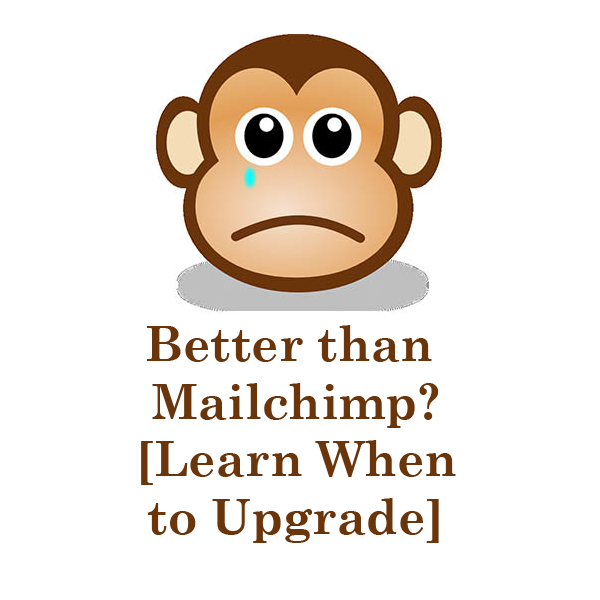
Don’t get me wrong–I love Mailchimp and I used it for years as my main email provider. I looked at a lot of packages when I started, things like Constant Contact and AWeber, but nothing beat the simplicity and core features of Mailchimp.
And then I outgrew it.
Note: If you’re at the very beginning of your online marketing journey, you should read this article so you understand what your future may bring. Then, make a decision based on how far away you think a need for this fancier stuff may be. If it’s more than a year away, and there is probably plenty you can do during that year that’s more productive, I’d encourage you to start with Mailchimp. It’s really pretty easy to upgrade down the road and there are no real penalties.
Have You Outgrown Mailchimp?
When people hear I switched off Mailchimp, they’re surprised.
What’s the deal? How did you outgrow Mailchimp?
Hey, it just happened one day. I woke up with a set of initiatives I wanted to implement for more growth on my CNCCookbook business. Let me tell you my story so you’ll understand.

No ROI from email?!??
I had a huge mailing list of 50 thousand names, I had read many articles suggesting Email has the highest ROI of any kind of marketing you can do. Just one problem:
I couldn’t measure much of any ROI from my Mailchimp Email efforts.
Whoa! I must be doing this email thing all wrong if I can’t measure any ROI from the highest ROI marketing investment I can make. I have got to improve that right away!
So I dug in to see where I was screwing up. I tested subject lines until I got my open rates up. I tweaked the heck out of the content. I basically had 3 lists in Mailchimp. I had my weekly blog article newsletter and free trial signups for two products I was selling. But try as I might, I could not get people to click through in ways that produced measurable ROI.
So I dug deeper. I researched conversion-oriented email campaigns. What I found was a revelation.
Email has an average ROI of $38 for each $1 spent, according to a VB Insight Study. I wasn’t seeing anything close to $38 of ROI. Perhaps part of the issue was uncovered when I found a study from DMA that suggested that 77% of email ROI comes from segmented, targeted, and triggered campaigns. I wasn’t doing any of that!
You Need Email Personalization to Maximize Conversion
In researching topics like “Lead Nurturing” from marketing experts I respected, I discovered that Personalization is a big key. Segmenting, targeting and triggering are all personalization methods. Personalization means sending email whose content is based on the state of each person. The emails are personalized for each reader, in other words.
Here’s the problem:
Approximately 96% of visitors to your web site are not ready to buy.
Not everyone is ready to buy at any given point in time. There’s a journey people follow through the sales funnel. When they come to you, they are at many different points in that funnel. Here’s a classic funnel to help you visualize these stages:

For example, they may be searching for very general topics. Those people are way up at the Top of the Funnel at the “Awareness” stage. It’s called that because you’re trying to create “Awareness” in them. Awareness that the problems you fix even exist and that they actually are suffering from those problems. These prospects are cold and will need a lot of warming up before you can ask them even to try a free trial let alone buy a product.
They may be searching for topics related to the problem that your products solve. Getting warmer–these folks are mid-funnel prospects. They’re somewhere in the span from “Interest” to “Intent” depending on whether they’re just curious, or they’ve actually decided they need to solve the problem and are seeking solutions.
They may be searching for your product by it’s brand name. Ding, ding, ding, winner winner, chicken dinner! These leads are HOT! They’re coming in at the Evaluation stage or maybe even the Purchase stage.
Now, based on even just those three distinctions, it should be pretty obvious you want to handle each one differently. Information that helps top- or mid-funnel (incidentally, the buzz words are TOFU for top and MOFU for middle) leads move down the funnel may just be irritating distractions for someone who came to the site just wanting to buy.
Likewise, hitting a TOFU lead with a zillion popups exhorting them to break out their credit card and buy is going to cause them to run for the hills thinking your site offers nothing but spam.
These things apply to the navigation paths through your site as well as to the emails you’re sending out. Mismatching emails to the needs and current funnel position of your subscribers kills the effectiveness of the email.
How Can I Personalize Email to Fit Funnel Position?

How can I personalize and segment my Emails?
A product like Mailchimp doesn’t give you very many tools to help Personalize the emails to your audience’s needs. At best, you might create different lists that are signed up for on different pages. That’s what I did with my weekly newsletter versus my trial signup. Going for the free trial was a pretty strong indication they were near bottom of funnel.
But it wasn’t enough. I wasn’t doing well on ROI.
I wanted to create some special email programs to do the following:
- Onboard new visitors to my brand. This was quasi-doable in Mailchimp because it is so generic. I just wanted to make sure that new subscribers to the newsletter got a big shot of my very best articles so they’d learn to love my brand and would be excited about future emails.
- Get prospects content that walked them through the journey from Top of Funnel (“interest”) down to a point where I could ask for a Trial (“Evaluation”). This was next to impossible in Mailchimp.
- Once the prospect started a Free Trial, I wanted to further personalize to make their onboarding and subsequent experiencing of the “Aha Moment” (that time when they realize they want this product) as likely as possible.
- I wanted to further personalize all of this to discover what Persona each user was and to use that Persona to customize what messages I sent to them.
As an aside, a Persona is sort of an idealized customer template. Every business will have customers that fit into some set of Personas. For example, in my CNCCookbook business, I have these Personas:
- Absolute Beginner: They’re just starting out and want very basic instructional material as well as inspirational material that doesn’t take much expertise to appreciate. My job is to convince them that my products will save them climbing a steep learning curve and radically increase their chances of success. They’re mostly afraid of failure because they realize they’re noobs.
- Experienced: These folks know their stuff. They want material that shows them how to do something they do often more easily or better in some way. My job is to convince them my products will make their job easier or better.
- Niche: I have several niche personas. These are subsets of the Experienced Persona that fit into some niche that requires special content and product features. My job is to feed them that content and make them aware that my products are uniquely suited to their niche. They may require different terminology for their niche as well as reassurance that your product isn’t one-size-fits-all, but that it really has some special benefits for the niche. Invariably, these folks are frustrated that their niche is under-served by content and products.
This was going to take some doing and was pretty much impossible in Mailchimp. Once I realized that, I started researching how these things could be done in other Email offerings. I needed to understand the Tools of the Trade for personalizing email.
Tools of the Trade: Email Features for Personalization

In order to Personalize, your email software needs two things. First is the ability to track what users do. It is often their actions that will inform you who they are, although sometimes you can also get them to tell you directly.
Second is the ability to do something differently based on how users have acted in the past.
Here is that lead funnel again, but I have overlaid examples of the actions users might perform that tell you it’s time to move them to the next funnel stage:
Action tracking
![]()
As you look at the funnel diagram above, we can see that it is valuable to track certain actions:
- Did they read a particular article?
- Did they sign up for a free trial?
- Are they using the product at all? Did they get it installed and running in the case of my software products?
- Did they experience the “Aha Moment” in the software.
- Did they purchase yet? It isn’t shown on this diagram, but my email automation will tell them their free trial is winding down, encourage them to buy before it does, tell them when it expires, and then revisit them down the road to ask why they didn’t buy, offer them a new trial, and so on. I can’t do all that unless I know whether they’ve purchased.
- Did they open an email? Not on the funnel, but I use this for things like resending if they haven’t opened within a certain time. This strategy increases open rates without causing too many complaints.
- Which links in the email did they click? Also not on the funnel, but I use this constantly to help categorize leads. Think of it as being able to create a multiple choice quiz in the email that they will answer. You can even ask them direct questions and tell them to click the link corresponding to their answer.
If I break this down even more, knowing whether the prospect has read an article happens only if the email software can instrument your web site and tie the visitor to a particular page to an email. You can do a little bit with link tracking (which links did they click in an email), but they may also find the page without clicking an email, and you want to track that.
Those are the fundamental kinds of actions we want to be able to detect and track. Next up are features that allow us to record past actions so we can act on them later.
Lists
![]()
List membership can be a good way to record past actions or otherwise segment an audience so they’re treated differently. This was the only tool I had in Mailchimp, and it isn’t very flexible. I mostly use it for big distinctions that are unlikely to change or have much crossover.
For example, on CNCCookbook I mention this blog and its small business-oriented articles. Not every visitor owns a small business or wants to start one. But if I decide they below, I add them to a special list which largely tries to get them to join and follow this blog.
Tags
![]()
Tags are probably my most powerful tool. Imagine being able to put arbitrary tags on any email name. Here are some of the things I use them for:
- Persona Tags: Which Persona(s) do they fit? What special interests do they have that I can feed?
- Trial Tags: I have tags that show they are in a trial and tags that show they let a trial expire without buying for each product.
- Import Tags: I frequently import names from other tools in my arsenal. I always tag everything imported in case I have to track it down and undo something later or figure out why something happened the way it did.
- Special Temporary Tags: For example, to track the stage in the onboarding process they’re in–downloaded it, logged in for first time, used key feature A, used key feature B, etc..
- Partner, Affiliate, and Referral Tags: So these customers who came to me from 3rd parties are handled differently.
Sometimes you have to get creative in order to create the Tags based on what actions your email software can monitor. I often use visiting a particular web page to set a tag, but I may do it in various sneaky ways. For example, when you login successfully to my software for the first time, it pops up a browser window that shows a “Welcome!” page. The user likes to get the nice welcome and my email software knows they logged in because that’s the only way to get to that page.
User Defined Fields
![]()
Tags are either ON or OFF. They’re limited in what they can represent. User Defined Fields can save a number, date, or text, so they’re much more powerful.
For example, maybe you want to record someone’s birthday so you can send them a special Happy Birthday discount on their birthday, or even a free gift. That’s kinda cool, eh? Well, you need a User Defined Field to hold their birthday.
In my case, I sell software by subscription. So I use User Defined Fields to record the date the subscription starts, the date it ends, and how long the term is. This makes it easy for me to send them reminders to renew. I might even give them a small discount if they renew early just to reduce my churn.
Or, I might want to checkin a little while after they buy to offer them an upsell or some special tips or other information that’s mostly of value to someone who bought.
You can do a lot of interesting things with User Defined Fields if you’re creative.
Lead Scoring
![]()
Lead Scoring is one of my favorite features!
A lead score is something that starts at zero, and you can increase or decrease it based on the user’s actions. it can be a sort of guide to how far down the funnel they are, for example. Or a trigger to move them a step further down the funnel (and you may tag their funnel position too!).
For example, when someone joins my weekly newsletter, they get on my “Greatest Hits” mailing. It gives them 5 of my Greatest Hits posts each week and runs for 6 weeks. But, the 5 articles are chosen not just because they’re greatest hits. They’re also chosen because they categorize my 5 Personas.
Now I also keep a Leadscore for each persona. Every time they click (or read directly) an article that corresponds to a persona, I add 5 points to the lead score. Every 30 days, I deduct 5 points so that if it was a temporary interest, it goes back down.
Now I am measuring how interested they are. A couple of the Personas / Lead Scores correspond to my products. I have special bonuses there. If they visit the product home page, that Lead Score goes up 15 points. If they look at pricing, that’s another 15 points.
When a product’s Lead Score hits 30, I fire up the Lead Nurturing Automation. That starts sending them articles much closer to the bottom of funnel that show them specifically how the product works to solve problems they are likely interested in. Every 2 of those emails and it asks them to take the free trial.
See how powerful Lead Scoring can be?
Automation vs Campaigns
![]()
The terminology for these concepts is all over the map depending on the Email provider, but I like these two words.
Campaigns are what you’ve got in Mailchimp. They fire up and send a series of Emails. The only intelligence they have is who you choose to fire them up for and how long between each email to wait.
Automations are the Next Step. They are often visual flowcharts that let you change what’s happening based on Tags, Actions, User Defined Fields, and other things.
Here’s an example from my ActiveCampaign automation during the free trial:

Sample Automation from Active Campaign…
it’s a simple flowchart that waits 2 days from the prior email then checks whether the Prospect has purchased (it’s checking whether the subscription end date is after the current date). If they have, it takes them off the Trial Countdown so it won’t continue to nag. If they have not, it waits for an ideal time of day (mornings are best for my audience to get the highest open rates) then it sends the email for the 27th day of the 30 day free trial.
Integrations
![]()
Integrations become more important as your needs become more sophisticated. Back in my Mailchimp days, I needed 2 things:
- Ability to see who signed up for a particular list via API. This is how my software recognizes when you sign up for the free trial.
- Ability to tie leadgen forms into Mailchimp. Their builtin stuff is weak compared to things like SumoMe.
That’s basic stuff and easy to come by.
Down the road, I wanted more and more integrations. I wanted to integrate my Shopify so the email knew what was happening there. I wanted to integrate Facebook Pixels for remarketing. I wanted to use the ultimate integration Swiss Army knife (Zapier) to plug all sorts of other things together.
Mailchimp is very popular, so a lot of integrations are possible. But, I needed the integrations to interact with Personalization too. Given Mailchimp’s lack of Personalization features, this meant that when I went looking for a step up, I would always check into it’s integration possibilities.
Conclusion

Phew!
Long article, but now you know a lot more about what’s possible with Email Personalization. You have some great examples of how it can help. And, you also know what kinds of features are used to implement Personalization.
If you’re wondering what I did, I actually evaluated multiple email packages that had these features I needed. After spending a lot of time, I settled on Drip and started to try to use it. Unfortunately, after investing a solid 6 weeks, I determined it wasn’t up to the task. Nice product, but there were a lot of shortcomings. I needed something better.
My next choice was ActiveCampaign. Wow! It’s like Drip made industrial grade and with a whole lot more. I have not been disappointed in any way ever since.
If you want to take the next step and get started with email personalization so you can increase the ROI of your emails, I highly recommend ActiveCampaign.

If this article resonated and you'd like more just like it, sign up for our Entrepreneur's Newsletter. You'll receive a free mini-course Work Smarter and Get Things Done. It teaches you how to maximize your productivity so you can get everything you need to do for your business done. It even includes our free productivity software to get you organized, focused, and productive.
Bob, Good morning,
Please pass you judgment on my invention that every needs.
To see it in action click on http://www.cncsetuphelper.com and watch two videos.
That invention made possible for a twenty year old kid who had never seen a machine shop before make set ups faster and much more accurately than a machinist with decades of experience.
Without it we would have broke long ago.
Sincerely,
Ilmar Luik
Luik, I like your setup helper.
Hi Bob
I am also feeling like I am outgrowing Mailchimp’s functionality, especially when it doesn’t appear I’ll be paying much more for Active Campaign’s extra features.
My list is tiny (1100) compared to yours but as a fellow engineer and solopreneur, I am also looking to get the best “bang for my buck” too. Drip was on my list but your article has definitely swayed me.
Would you comment on your feelings three months down the track? Is Active Campaign working out for you?
Cheers
Matt
Matt, I’ve had well over a year with ActiveCampaign now and I am still completely sold on it. You can always come up with things to improve, but I’ve been able to do everything I needed to with ActiveCampaign.
Hi Bob
Thanks for taking the time to reply. I am also following Bryan Harris of Videofruit and he recently conducted a detailed review of six big ESPs. His review of Active Campaign wasn’t flattering.
http://videofruit.com/blog/activecampaign-review/
I’d be interested in whether you have the same criticisms. If I listened to Bryan, I’d probably give Active Campaign a miss. But reading your post makes me want to sign up immediately. Anyway. I know you are busy but I appreciate both this site and CNCcookbook. I have a small CNC router and yes I am a customer 🙂
Cheers
Matt
Matt, what does videofruit’s http://whatemailserviceshouldiuse.com/ recommend for your needs?
It recommended ActiveCampaign when I went through it, so for starters, Bryan Harris agrees with my choice at least for CNCCookbook, LOL.
For your own needs, at some point you need to quit listening to the pundits like Bryan and me and go use a package. Seriously. They are all going to seem kind of hard and arcane until you use them for a while. Read the reviews, pick a couple, try their trials to see how they go. Hopefully one really resonates and you go with it.
As for Bryan’s review, he has 3 complaints in his review of ActiveCampaign:
1. He thinks the UX is lousy and it’s too hard to use.
2. He thinks it is too slow.
3. He doesn’t like the use of lists.
Let’s take them one by one.
#1 Lousy UX and too hard to use
Bryan uses Infusionsoft, which a vast number of people (even loyal users) call “Confusionsoft” because of its difficult UX. Google for a laugh.
But oddly, while Bryan finds some faults with Infusionsoft, he never says it has a difficult UX or that it’s hard to use in the Infusionsoft review. He says it’s old and crufty and the Soyuz, but he doesn’t rant as he does with ActiveCampaign. He does own up to it in some of the other reviews, but geez, shouldn’t the reviewer bring up this whole “Confusionsoft” meme in the review?
That should be enough to make you wonder about his judgement when it comes to ease of use, right there. BTW, I had to see what he said about Drip, which I think has a better UX than ActiveCampaign, but which I still found unusable. He winds up saying it’s too hard too.
Here’s the thing. All software, every single package, no matter how glowingly reviewed is hard to impossible to use. For a certain audience.
That’s right, no matter how good your UX skills, someone out there is going to think your software is terrible. Bryan is that guy that thinks ActiveCampaign is terrible. I don’t agree.
He also says Drip is too hard. I think in the end, these are feature rich products for power users. He’s running around reviewing them, but he isn’t living with them long enough to really master them. Except for Infusionsoft. That’s probably why he complains so much about the others.
It is hard to learn all those features. It’s hard for ANY of the options. Take a package he says is easy–ConvertKit. But then he bashes the heck out of their ability to do any advanced automations.
I don’t think there is a package that is easy like ConvertKit and that does advanced automations just as easily. Rather than complaining about how hard some of these packages are, Bryan should get some perspective and just admit that if you need those functions, life will be harder.
#2 It is slow.
I have seen this and really fretted about it for a long time. And then I discovered something. My home DSL is lousy. I get maybe 1 MB on speedtest most of the time.
My iPhone hot spot is much better–5 MB.
When I access ActiveCampaign with the Hot Spot, the parts that seemed slow became crisp.
Voila! Slow was a self-inflicted wound. Get a good Internet connection.
#3 Their use of lists
This one really made me feel like Bryan hadn’t really “lived” ActiveCampaign. BTW, he admits it in the ActiveCampaign review:
“By the end of my first major session with the app, I wanted to pound my head against my desk.”
Matt, as a CNC’er, go try a bunch of CAD Software. ALL of it will have you pounding your head against the desk if you think you can master it in a day, LOL! BTW, I’m an “expert” on such software, and it makes me bang my head too. In fact, and this may also be Bryan’s problem, being too familiar with a solution (like Infusionsoft) makes you prefer everyone work as the one you know does. It doesn’t necessarily make it right for others.
It’s particularly to stay objective once you thoroughly confuse yourself by reviewing a whole bunch of packages that all work completely differently.
Here’s what he says about lists, “The most perplexing part of ActiveCampaign is that they are a CRM and tag-based email service, but they insist that you use lists to send broadcast messages.”
Here I have to call total BS. He wants to send a broadcast email, not an automation to a group of people. You need to identify which people somehow. He’s upset that he has to create a list to do it. But I have some thoughts on that (natch!).
First, it isn’t like it’s hard to create a list. It takes a matter of a few clicks to turn a segment or anyone with a particular tag, or even a complex query into a list. So why is this such a big deal for Bryan? Not hard to creat lists at all. I create throw away lists all the time for various purposes. Sometimes just so I can keep count of how many people fit in a certain group, for example. In other words, I might not even ever send the list an email.
Maybe for Bryan it’s just the idea that it is hard if you’re trying to do a totally contrived I only have to do this once for a review scenario. OK, but…
Second, who else will I send broadcast emails to but lists? If I have some group of people that I am going to frequently send random emails out to when the mode strikes me, doesn’t it seem like that group is identifiable and should be on a list? Like, I don’t know, maybe everyone that uses one of my products? Yeah! Why not create a list for those people?
Or, everyone who is a beginner? Woohoo! Maybe a list is a good idea!
Prefer tags? Great, tag the same groups and create lists as needed when you send the email. Oh, you have to do it a bunch of times? Well isn’t that what automation is for and doesn’t ActiveCampaign have some of the best automation in the business?
Yeah, I really don’t get what Bryan is on about with this. It seems to me like he was just really tired of reviewing software by this point. But he shouldn’t be transferring his grouchiness into his reviews. That’s not the job of a reviewer.
Wow! Thanks Bob, didn’t expect you to put so much time into that response. His site had recommended Drip for my needs which is why I was headed down that path.
But based on your feedback, I’ve just signed up for Active Campaign. Thanks for the “push”!
Cheers
Matt